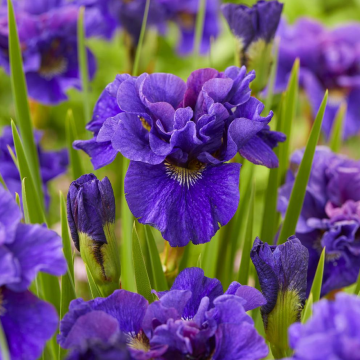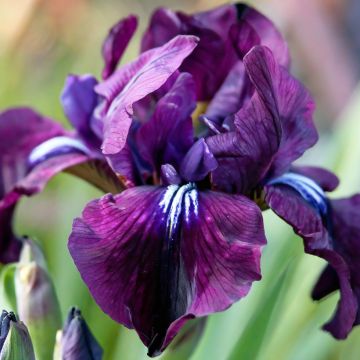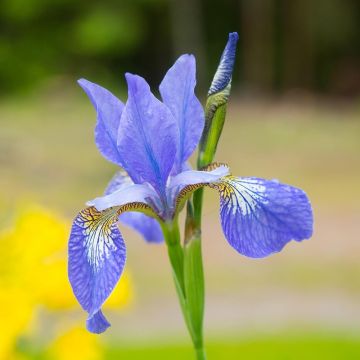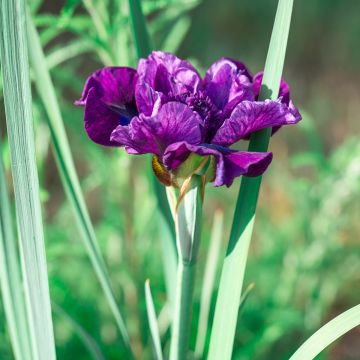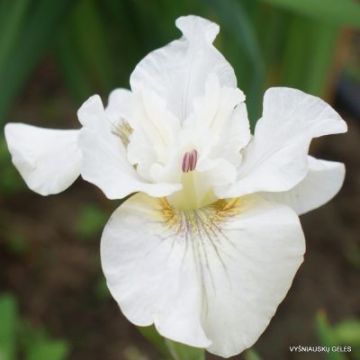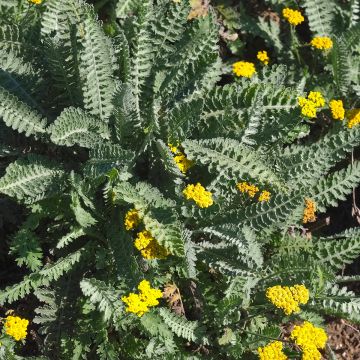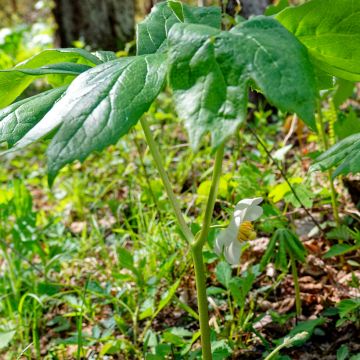

Iris sibirica Dance Ballerina Dance - Siberian Iris
Iris sibirica Dance Ballerina Dance - Siberian Iris
Iris sibirica Dance Ballerina Dance
Siberian Iris, Siberian Flag
My order was perfect, but I found the iris to be really thin, and I hope it will produce beautiful flowers for me.
Catherine , 22/10/2024
This plant carries a 12 months recovery warranty
More information
We guarantee the quality of our plants for a full growing cycle, and will replace at our expense any plant that fails to recover under normal climatic and planting conditions.
From €5.90 for pickup delivery and €6.90 for home delivery
Express home delivery from €8.90.
Does this plant fit my garden?
Set up your Plantfit profile →
Description
Iris sibirica 'Dance Ballerina Dance' produces beautiful white and lilac-pink flowers with a touch of brown at their centre. This perennial plant blooms in spring. It forms a sculptural clump of linear, green leaves reaching 50 to 60cm (20 to 24in) high. The deciduous leaves turn yellow in autumn before you cut them. Easy to grow, the Siberian iris thrives in sun and partial shade in warm climates and adapts to any soil that is not too dry.
Iris sibirica is a rhizomatous perennial plant of the Iridaceae family. In its natural state, it grows on heathlands and moist meadows in central and eastern Europe, northeastern Turkey, and Russia. In France, it is considered an endangered and protected species. The proposed varieties are notably derived from the hybridisation of I. sibirica and I. sanguinea. Their flowers are generally larger and present a great diversity of colours.
‘Dance Ballerina Dance’ was obtained in 1982 by Steve Varner. It forms a robust clump of narrow, upright, deciduous leaves. In May-June, unique and bicolour flowers emerge from the foliage. The 3 sepals are light lilac-pink marked with a golden-brown tip at the base and the 3 petals and stigmas are white, thus offering a delicate contrast. The flowers reach a height of about 80cm (32in). In autumn, the leaves turn yellow and dry up.
Plant 'Dance Ballerina Dance' in groups to create a mass effect or plant it with other varieties with complementary colours. Iris sibirica 'Sparkling Rose' and I. 'Rikugi Sakura' will work particularly well. It is the ideal plant to vegetate the surroundings of a water feature or pond or if your soil is moist. It will also make a sensation in an English garden, in a mixed border or a bed. Plant it with other pink perennial plants fond of moist soil, like the daylily 'Amethyst Jewel' and Delphinium 'Strawberry Fair'. Once well established, it withstands drought quite well, but it will be more comfortable in not too dry soil. Its flowers are ideal for making bouquets.
Report an error about the product description
Flowering
Foliage
Plant habit
Botanical data
Iris
sibirica
Dance Ballerina Dance
Iridaceae
Siberian Iris, Siberian Flag
Cultivar or hybrid
Other Siberian Iris
Planting and care
Iris sibirica 'Dance Ballerina Dance' appreciates rich and moist, even damp, soil that is slightly acidic to neutral. In heavy soil that may become waterlogged, plant your iris on a small mound. Add a good amount of well-decomposed compost at the time of planting. If your soil is chalky (alkaline), adding ericaceous soil will help acidify it. Even though the Siberian iris prefers moist soil, it can tolerate short periods of drought once established. Choose a sunny or partially shaded location. It needs a daily dose of sunshine (at least 6 hours) to flower.
In terms of maintenance, it is a relatively easy plant to care for. Simply cut the flower stems at the base after flowering and remove the dry foliage once it is no longer decorative. Cut it and leave it in place as mulch.
Planting is usually done during the dormant period, from late September to mid-April, outside of freezing periods. In warm climates, plant as early as September, while in regions with cold winters, wait until late March or early April. In this case, your irises will only flower the following year. Plant the rhizomes at a depth of 3 to 5cm (1 to 2in). Siberian irises can remain in place without division for about ten years. When the centre of the clump no longer flowers or forms a crown, it is time to divide. The ideal period is the end of winter, in February-March.
Planting period
Intended location
Care
-
, onOrder confirmed
Reply from on Promesse de fleurs
Spring flowering perennials
Haven't found what you were looking for?
Hardiness is the lowest winter temperature a plant can endure without suffering serious damage or even dying. However, hardiness is affected by location (a sheltered area, such as a patio), protection (winter cover) and soil type (hardiness is improved by well-drained soil).

Photo Sharing Terms & Conditions
In order to encourage gardeners to interact and share their experiences, Promesse de fleurs offers various media enabling content to be uploaded onto its Site - in particular via the ‘Photo sharing’ module.
The User agrees to refrain from:
- Posting any content that is illegal, prejudicial, insulting, racist, inciteful to hatred, revisionist, contrary to public decency, that infringes on privacy or on the privacy rights of third parties, in particular the publicity rights of persons and goods, intellectual property rights, or the right to privacy.
- Submitting content on behalf of a third party;
- Impersonate the identity of a third party and/or publish any personal information about a third party;
In general, the User undertakes to refrain from any unethical behaviour.
All Content (in particular text, comments, files, images, photos, videos, creative works, etc.), which may be subject to property or intellectual property rights, image or other private rights, shall remain the property of the User, subject to the limited rights granted by the terms of the licence granted by Promesse de fleurs as stated below. Users are at liberty to publish or not to publish such Content on the Site, notably via the ‘Photo Sharing’ facility, and accept that this Content shall be made public and freely accessible, notably on the Internet.
Users further acknowledge, undertake to have ,and guarantee that they hold all necessary rights and permissions to publish such material on the Site, in particular with regard to the legislation in force pertaining to any privacy, property, intellectual property, image, or contractual rights, or rights of any other nature. By publishing such Content on the Site, Users acknowledge accepting full liability as publishers of the Content within the meaning of the law, and grant Promesse de fleurs, free of charge, an inclusive, worldwide licence for the said Content for the entire duration of its publication, including all reproduction, representation, up/downloading, displaying, performing, transmission, and storage rights.
Users also grant permission for their name to be linked to the Content and accept that this link may not always be made available.
By engaging in posting material, Users consent to their Content becoming automatically accessible on the Internet, in particular on other sites and/or blogs and/or web pages of the Promesse de fleurs site, including in particular social pages and the Promesse de fleurs catalogue.
Users may secure the removal of entrusted content free of charge by issuing a simple request via our contact form.
The flowering period indicated on our website applies to countries and regions located in USDA zone 8 (France, the United Kingdom, Ireland, the Netherlands, etc.)
It will vary according to where you live:
- In zones 9 to 10 (Italy, Spain, Greece, etc.), flowering will occur about 2 to 4 weeks earlier.
- In zones 6 to 7 (Germany, Poland, Slovenia, and lower mountainous regions), flowering will be delayed by 2 to 3 weeks.
- In zone 5 (Central Europe, Scandinavia), blooming will be delayed by 3 to 5 weeks.
In temperate climates, pruning of spring-flowering shrubs (forsythia, spireas, etc.) should be done just after flowering.
Pruning of summer-flowering shrubs (Indian Lilac, Perovskia, etc.) can be done in winter or spring.
In cold regions as well as with frost-sensitive plants, avoid pruning too early when severe frosts may still occur.
The planting period indicated on our website applies to countries and regions located in USDA zone 8 (France, United Kingdom, Ireland, Netherlands).
It will vary according to where you live:
- In Mediterranean zones (Marseille, Madrid, Milan, etc.), autumn and winter are the best planting periods.
- In continental zones (Strasbourg, Munich, Vienna, etc.), delay planting by 2 to 3 weeks in spring and bring it forward by 2 to 4 weeks in autumn.
- In mountainous regions (the Alps, Pyrenees, Carpathians, etc.), it is best to plant in late spring (May-June) or late summer (August-September).
The harvesting period indicated on our website applies to countries and regions in USDA zone 8 (France, England, Ireland, the Netherlands).
In colder areas (Scandinavia, Poland, Austria...) fruit and vegetable harvests are likely to be delayed by 3-4 weeks.
In warmer areas (Italy, Spain, Greece, etc.), harvesting will probably take place earlier, depending on weather conditions.
The sowing periods indicated on our website apply to countries and regions within USDA Zone 8 (France, UK, Ireland, Netherlands).
In colder areas (Scandinavia, Poland, Austria...), delay any outdoor sowing by 3-4 weeks, or sow under glass.
In warmer climes (Italy, Spain, Greece, etc.), bring outdoor sowing forward by a few weeks.


































